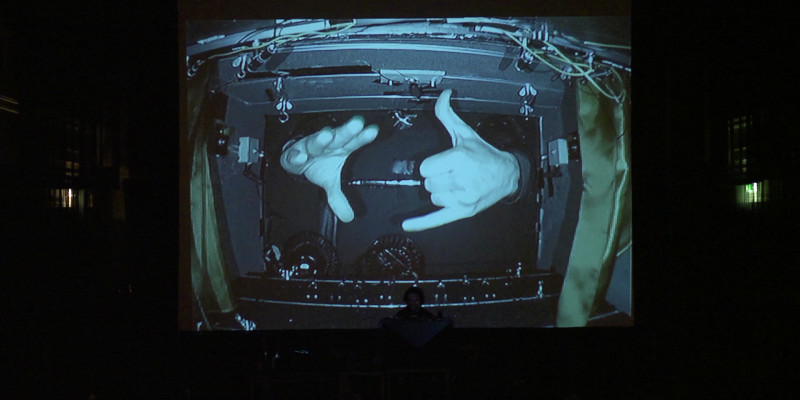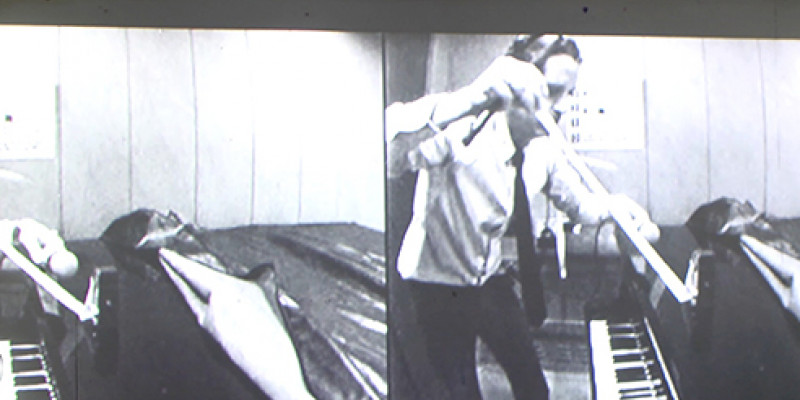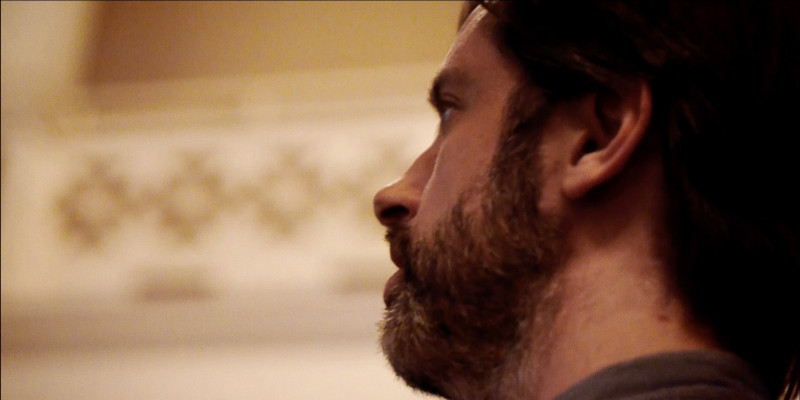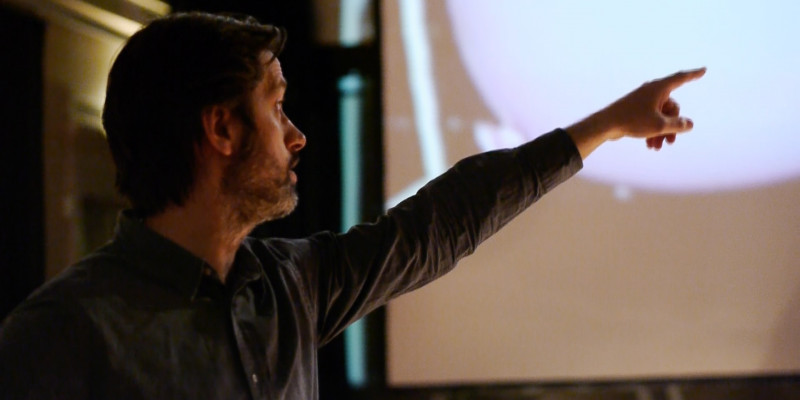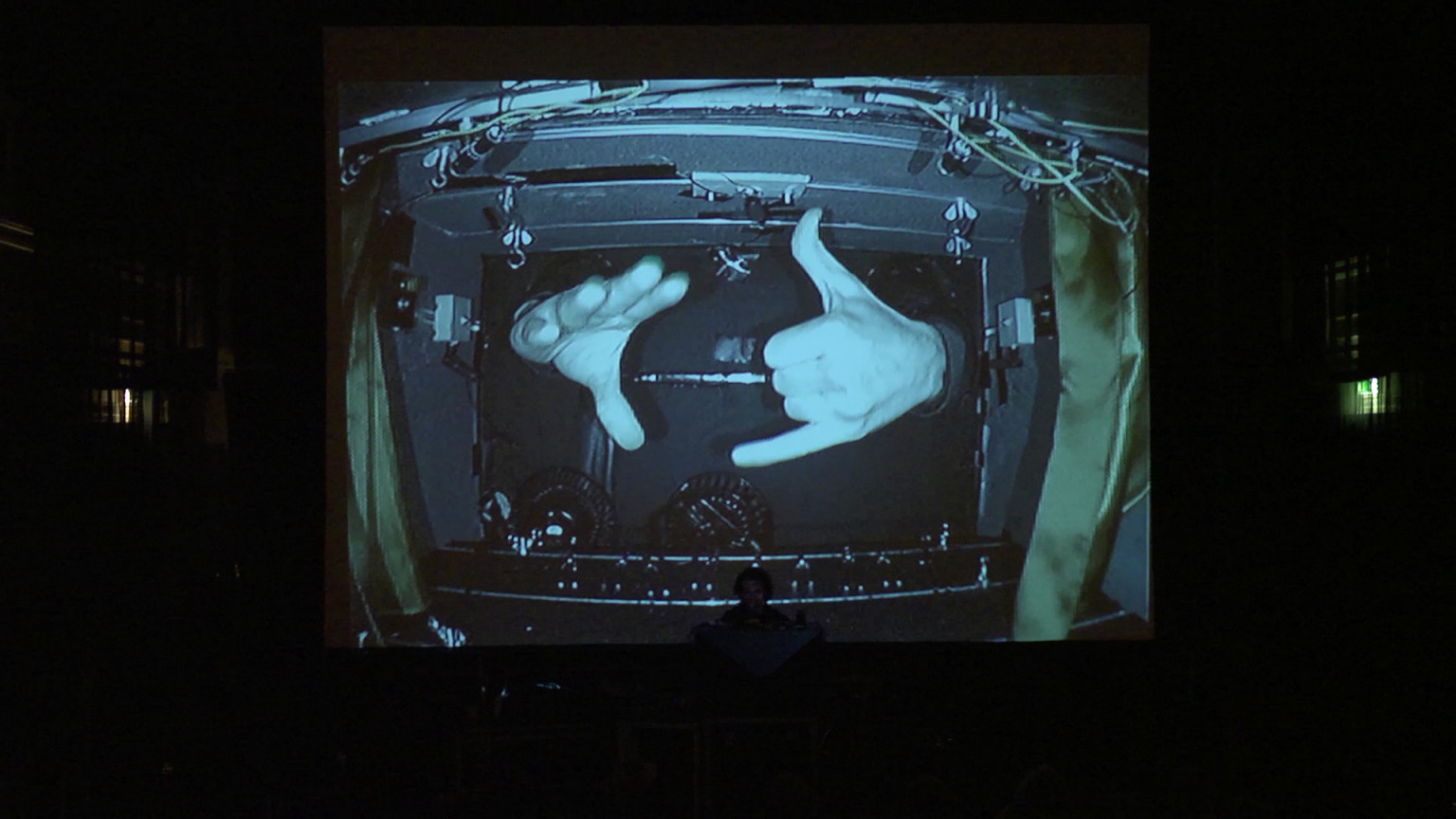
Have You Seen The Music?
A question like this most often concerns the reading or misplacement of a musical score – the primary visual appearance of Western art music. Or it is used as a rather bad metonymy for attending a concert, an activity, which most often involves a lot more hearing and listening than seeing. However, in the case of Simon Steen-Andersen it makes perfect sense to speak of a music that is both visual and aural. To him, visuals aren’t just a shiny surface-wrapping that makes the so-called ‘difficult music’ seem more accessible. On the contrary, the visual dimension is integrated as much as possible into the structure and nature of the works:
“When I work visually it is still music. I have the same preferences and I then employ them in turning the music into visual music. My aim is not to stand in one place [the music] and then add something else [the visual], but that I can be able to position myself inside the music and then expand it from that position. Instead of having music plus something else, I have a music that can also be visual. A visual music.”1
The present essay explores this notion of visual music in four different works written between 2003 and 2012, of which 2012’s Black Box Music shows the most comprehensive integration of visual and sounding aspects.
The on-going investigation
Simon Steen-Andersen often speaks about the abstract and the concrete dimensions of music. Music, he says, “is one of the most abstract art forms. Most often it only speaks about intra-musical content and hence its main reference is to itself or to other music.”2 The abstract in music, then, is what separates it from the world at large, from reality as such – and thus, also what separates it from having any real impact outside its own sphere of relatively small aesthetic cells of connoisseurs relating it to other music or to art history in general.
During the past ten years, a part of Simon Steen-Andersen’s practice has evolved around the concept of concretizing his music, not in the sense of musique concrète in its various interpretations, but in the sense of making apparent some of the inherent traits of music and musical performance, and using them as concrete materials in his compositions, for instance making the silent movements and gestures of musicians part of the compositions. For Simon Steen-Andersen the motivation for this is that “[…] the existence of musical sound is impossible to think independently from the actions and choices that create it.”3 As a consequence motion, behaviour, media, sociality and cooperation have been the themes and materials of this concretizing which, in short, deals with all that is tangible and with relations to elements outside the realm of ‘pure’ music. In other words, the process of concretizing is at the same time an expansion of the musical material to encompass a range of other aspects besides sound.
One of the main strategies in this concretizing is to incorporate the visual elements of music in his compositions. Exploring the visuality of music may seem a little odd or even far-fetched, but Simon Steen-Andersen applies ‘ordinary’ compositional methods to the visual material, thereby treating it in much the same way as any sounding musical material. The visual aspects of his music are, so to speak, concrete elements, that are inherent in the aural aspects of music, but here they integrated in the compositions.
As a result, much of the music of Simon Steen-Andersen is predominately suited for a live situation – music to be experienced in performance, by an audience, together and with both ears and eyes open. This may be interpreted as a wish to make the music relevant in the present and as a way for the composer to engage more directly with his audience.
Amplifying more than sound – performance as material
The piano piece Rerendered (2003) is not explicitly visual, but very subtly it points toward a visual aesthetic of music, which becomes even more pronounced in the newer works by Simon Steen-Andersen. The piece is written for a piano player with two assistants. A fourth performer – a conductor – is optional. The assistants play inside the piano, directly on the strings, pegs or stops, either making independent sounds or collaborating with each other and/or the pianist by using slide-tools, dampening or fingering out pre-marked harmonics on the strings - actually as a sort of live-preparation of the piano.
The work is mainly devoted to an extreme amplification of a very quiet sound world – the general dynamics is ppppp, and the pianist is instructed, that it “[…] is extremely important for the piece, that the “normal” notes of the piano are played as soft as possible. In a way it is better, that the pitch of a note does not sound at all, than if it sounds too loud.”4 The sound of the piano is amplified as much as possible, making even the quietest actions audible and at times even loud. Thus an almost hidden world of sounds emerges – the sounds of a piano turned inside out.
As to the visual side of the performance, the score indicates how best to place the piano on stage for the audience to see the musicians in action – or alternatively, that a video feed, shot from a camera directly above the piano, can be projected onto a screen for the audience to see. Rerendered has also been performed with a quadruple video projection composed by two shots from inside the piano, one from the keyboard and one from the piano pedals.
In Rerendered the musicians’ actions can be viewed as an investigation of the ‘hidden’ sounds of the piano, comprising a form of close-up sonority. But the loud amplification also reveals some of the unintentional sounds integral to musical performance: the flipping of a page of the score, the breathing of the performers or the soft rustles of their clothing while moving. Though the performers are instructed to keep these sounds at a minimum, they become an unavoidable and inherent part of the music, precisely through the relation between the extremely soft playing and a loud amplification. Thus, in amplifying the quiet we become aware that what is being performed in front of us is not just ‘pure’ music, but rather a situation and some actions, the outcome of which – is music. Displaying music as a collaborative and situated practice – musicians working together to produce sound – can then be seen as a way of concretizing the otherwise very abstract sound world of a prepared piano.
Adding the video projection of course enhances the sense of music as actions-performed-on-instruments, but in the last part of the piece, the visual aspect is further emphasized compositionally too, as the piano player plays chords that are not supposed to sound at all or is instructed to inaudibly lift his hands form the keyboard. This, in turn, highlights the performance situation as an integral part of Steen-Andersen’s compositional methods. Music is not just sound – the ways in which this sound is being produced are as valid a musical material as the sound itself.
Contemporarily classical
Run Time Error (2009)5 is a site-specific audio-visual performance, which Simon Steen-Andersen performs himself, controlling a stereo sound track and double video projection with two joysticks. The video (and sound) for this double projection are pre-recorded, on site, in advance of each performance and shows the composer playing energetically on a large number of objects, while also recording the sound of his actions with a hand held microphone.
The arrangement of the objects alongside each other describes a tour through the building using the backrooms, staircases, toilets or corridors of the particular site, thus turning the particular building into his instrument. The performance of this recording adheres to certain dogmas:
1. “Only objects and instruments found at the location can be used,
2. Each object or instrument can only be used once, and
3. Each sound/action must have an immediate point of association with its neighbouring sounds/actions.”6
When ‘playing’ the piece the composer distributes both sound and video into two channels – as a double video projection and a stereo sound diffusion. Both channels thus use the same material, which is treated and played back in a manner composed after the classical scheme of a two part invention. But it isn’t just a normal playback. Using the joysticks he manipulates the time and direction of the playback as the two sound-video projections go forward and backward, speed up and down, stop and start. The visual and aural effect of this resembles what is known as a ‘scrub-tool’ in sound and video editing software – a tool that allows for controlling the tempo manually with the mouse, in order to zoom in quickly and precisely on a certain point in time.
In this stretching, stopping, compressing and reversing of the run time, the compositional principles of the classical invention are evident from the start – even for an audience not familiar with classical forms. The form of the invention can be difficult to grasp by the ear alone – as for instance it is impossible to listen backwards in time or to listen simultaneously to two different points in time. For most people, a classical technique like the retrograde is only apprehensible through repeated listening or, for the ones fortunate enough to have the ability to read a score, through visual analysis. In Run Time Error, however, it is immediately and humorously obvious. Sound and image simply roll backwards.
This way of integrating sound and vision thus describes a different strategy in concretizing an abstract musical form. Through technology Simon Steen-Andersen lays it all out in the open and this relatively simple but highly effective gesture speaks in a language that most present-day listeners are familiar with. Twisting it further by controlling his recorded actions with joysticks in performance of the work, in fact turning him self into both the protagonist and game-player of this video game-like situation, only adds to the experience of a composer speaking a contemporary language.
In this way Run Time Error shows a predilection for working with classical forms as both an embracing and renewing relation to musical history. The meeting of classical musical form and video game aesthetics echoes the composer’s manifest from 2003, written on the occasion of his postgraduate diploma exam concert. Here he, among other things, states: “I have a concerned attitude towards art music, but, what is more, it is a positive concern.”7 He also distances himself from what might be termed the negative dichotomies inherent to modernism:
“I endorse most of the dogmas of modernism, but I’ve come to them not by theory but from experience. As such they are no longer negative dogmas (a rhetoric of prohibitions), but rediscovered positive tools to pave the way for an expression – tools to open up the possibility of creating something that is larger than myself. Part of this journey goes through the use of these dogmas against modernism itself. Against modernism as a negative figure, modernism as a battle against tradition. This exterior negativity of modernism places an almost overarching focus on the interval, or on the difference to the positive, the difference to what is rebelled against.”8
Taking a relatively simple classical form that hard-core high-modernists might have scorned, and combining it with a contemporary and playful situation, whose main feature is the manipulation of linear time, is exactly a positive rendition of modernism’s problems with history. Manipulating linear time in this very obvious way can be understood as a questioning of the entire concept of history as a successional and evolutional concept, which is also a question central to western modernism as such. Framing this time-manipulation in a classical (pre-modernist) form without trying to implode it or stretch it beyond recognition, but actually exhibiting it in a visual and contemporary language instead, shows a productive relation to history. A relation, where history can be a repository of ideas, forms and techniques that are at the composer’s disposal as truly creative and innovative tools – where tradition is a positive notion instead of a problem or a negative concept to criticize.
Run Time Error shows a more engaged artist than the archetypical image of the modernist composer prescribes. By using himself as material and by performing the work himself, Simon Steen-Andersen breaks down some of the barriers between artist and audience and especially between composer and musician. The idea of the secluded composer located within his ivory tower writing great works for possible futures to acknowledge is long gone – this is music for the present and for the people who inhabit the present.
Composing visually
If Rerendered primarily explored the actions of live-preparing a piano and its resultant sounds, Study for String Instrument #3 (2011) more directly deals with the visual language of music, which is also the main objective of the Study for String Instrument series as a whole.
Study for String Instrument #3 is a relatively simple composition – a duet for prepared solo cello (or guitar) and video projection. As such it is a two-voice piece, performed by one musician. The soloist pre-records an audio and video track, playing the one voice, which in performance is projected directly onto his/her body while playing the other voice.
The instrument is heavily prepared. The bow, which is used col legno throughout the piece, has masking tape on the stick producing a rasping, scraping or even saw-like sound. The cello (or guitar) has its three (or five) top strings dampened with cloth or masking tape. As a result they do not produce ‘normal’ tones – but only percussive sounds with no defined pitches. Only the bottom string is not dampened, but instead it is tuned down approximately one octave, emitting a very rattling, crackling or scratching sound when played pizzicato.
The two voices play similar material, which is treated with rhythmical variation, and this, combined with the heavy preparation of the instrument, makes it almost impossible to distinguish whether the sounds emerge from the musician playing live or from the pre-recorded video. There is almost no tonal material, no harmonies, no melodies – just the scratching, rattling and scraping sounds of a string instrument treated as percussion. For Simon Steen-Andersen, the preparation has the purpose of making the sound world of the piece more anonymous. Removing the normal sound and the normal ways of playing on the instrument also removes some of the listener’s associations and anticipations. The preparation is intended to facilitate that the listener does not listen for melodies, themes, harmonies or developments in a traditional sense, but instead is able to concentrate on the purely sonorous qualities of the sound. This is intended to free the listener’s mind from aural associations, which could stand in the way of the visual experience of the piece. Ideally, the purpose of the piece is "[...] to make music that is equally appealing to a deaf person as it is to a blind one."9
How, then, is this achieved? Actually it is already in the setup of the piece: By anonymizing the sound of the instrument and by having the two voices play the same basic material, the duet becomes primarily visual. Or put in another way: a duet, in which it is almost impossible to distinguish its two parts, does not make much sense as a duet. Though there certainly are sonorous nuances and hooks and subtle rhythmic motives in the sound of the piece, the obvious way to understand and become aware of these is visually. Without the movement it would be impossible to distinguish whether it is the musician or the projection producing a particular sound.
With the sound so closely shown as a result of the movement producing it, the basic musical material, then, is the movement of the musician, which throughout the piece is treated with consequent compositional methods such as variation, imitation, inversion, mirroring etc., applied to the movement of the musician and his projected double self. As such, it is an example of musical composition fully applied to the domain of the visual.
Inside the black box
A further investigation of sound and vision, which also shows an expanded way of construing this relationship, is Black Box Music (2012), which so far seems to be the culmination of this string in Steen-Andersen’s music. It follows the formal scheme of the solo concerto, but is in fact a scenic piece because the solo part is a kind of puppet theater performed inside a specially designed ‘black box’ and projected onto a large screen. The introductory notes in the score state that:
“Note
Black Box Music is scored for percussion solo, amplified box, 15 instruments and video. The starting point is the classical soloist-conductor, only in this case, the conducting and solo part are one and the same. The setting is a traditional theater stage with curtains, props and lighting, only in this case, the stage is also an instrument. Black Box Music could be said to be a deconstruction of conducting and puppet theater as well as an exploration and exploitation of the audio/visual relations inherent in conducting and staging.Performance notes
The ‘Black Box’ is a specially constructed box, the interior of which is outfitted with microphones and various objects. The box is a kind of mini puppet theatre with holes in its rear wall through which the soloist places his/her arms. The front of the box is covered with a curtain, turning it into a mini theatre space. A view from the front of the box is projected via live video feed onto a wall/screen in front of the audience.”10
In this space Simon Steen-Andersen stages a staggering showpiece with a quasi-narrative that turns the traditions and the conventions of conducting inside out hereby adding a humorously ironic and critical extra-musical edge to the investigation of a visual music.
In the first movement the setting is presented and the possibilities of the black box and the different functions of the soloist are examined. Curtains and lighting play an important role implying the presence of both a backstage and an onstage conductor-protagonist vis-à-vis an ensemble with its own will. Quickly, different sorts of gestures and hand signs, not familiar to conducting, become part of the soloist’s actions: Thumbs up, bull, phone, the speaking hand, a firing gun, “quasi rock-paper-scissors” and other gestures act as ‘characters’ comprising a small narrative. In relation to the visual, the music has both a diegetic and a non-diegetic function – moving back and forth between depiction, description and interaction – in relation to the actions performed inside the black box. Sometimes the musicians follow the conducting, sometimes they’re insubordinate and sometimes they illustrate the scenic narrative. The solo part is primarily visual, though the sounds of e.g. the soloist knocking on the box floor or the turning on and off of the lighting mixes into the overall ensemble sound.
The second movement is slower and more introvert and the distribution of roles between ensemble and soloist takes on a more traditional shape. Where the music in the first movement is fragmentary and abrupt, here it becomes more fluent and coherent: solo with accompaniment. The soloist has stopped conducting to perform a solo on tuning forks with discrete entries from the ensemble. Initially the tuning forks are ‘out of tune’, creating interference tones, but gradually they build up a chord and the movement resolves on what could be interpreted as a tonic C, implying that order is restored and the ensemble and soloist are now on the same wavelength. Tellingly, the movement is titled “Slow Middlemovement” – the conventions of the genre are resurrected.
The third movement is the grand finale and a chaotic climax. From the initial ‘tapping of the conductor’s baton’ in order to call the musicians to order the music commences in a rhythmically swinging solo featuring finger snapping. Soon the roles switch and it is the ensemble that tries to call the conductor back to order, but seemingly too late. From here the stage is gradually turned into a chaotic quasi-mechanical theater-installation, in which the soloist plays frenetically on rubber bands, small ventilation fans, plastic cups, and finally fills the stage with streamers and tosses in a balloon, making it impossible for the music to continue. From a heavy and sometimes conflictual thematizing of the relationship between conductor and ensemble in the first two movements, this finale shows a collaborative interplay between them – but one that ends in chaos, like the smashing of the instruments at the end of a rock concert.
For an overall consideration Black Box Music combines the different strands of Simon Steen-Andersen’s visual music. It is a scored and thoroughly composed choreography for hands turning the conventions of conducting inside out in a playful manner. Thus it uses the ‘performance’ of the classical conductor as its musical material. It is built on a classical formal scheme combining it with a visually appealing theatricality, marking an updating of tradition. The aural and the visual are treated equally and are utterly interconnected, the one making little or no sense without the other. Still, Black Box Music is deeply concerned with sound and timbre using a richly nuanced and highly differentiated instrumentation to orchestrate and illustrate the different roles of the ensemble-soloist relation. The musicians are divided into three groups, surrounding the audience (having the projection of the black box on the fourth side), thus effectively putting the listener/spectator at the centre of the event, allowing for a vivid feeling of live surround sound that most movie theaters would envy.
Materializing the institution
At the same time as the experience of Black Box Music directly addresses the role and function of the classical conductor, the title of the piece echoes a much wider context. In theater terms a black box is a performance space stripped of all unnecessary exterior – a blank space where theater can be experienced in its essence through a shutting out of the surrounding world. It is also exactly what the term designates – a black square room that is easily adjustable to the needs of experimental theatre, and as such the black box theatres has proliferated from the 1960ies and onwards. This is a development that is in many ways comparable to the rise of the white cube of the art gallery.
Speaking about these white cubes, or blank gallery spaces, in his famous series of essays in the magazine Artforum in 197611, the art critic Brian O’Doherty pointed out that the function of the white gallery space actually is contrary to the intention. Instead of giving the desired attention to the individual artworks, the whitening of the walls turns the gallery into a kind of sacred place or a cathedral for the art – and as such it points directly to the conventions of art consummation, the ‘artificial’ character of art, and the art experience’s segregation from lived everyday live. In other words it points directly at the institutionality that much 20th century avant-garde art sought to destroy or at least circumnavigate in its experiments. By choosing the title Black Box Music and filling up his black box with a playful display of conventions, it seems that Simon Steen-Andersen tries to utter a voice in this debate.
To me at least, there is a direct connection to the avant-garde tradition of instrumental theatre of the 1960ies and 1970ies. The use of tuning forks in the second movement quite clearly references Mauricio Kagel’s Repertoire from Staatstheater (1969-70), as does the use of the various sound producing objects in the third movement and the general use of musical conventions as the subject matter of the piece. But the very explicit criticism of conventions in Kagel’s piece takes on quite a different form in Black Box Music where Simon Steen-Andersen carefully exhibits and investigates the conventions, but refrains from mocking them. He simply puts the conventions on display, deconstructing them without attempting a reconstruction – consequently the finale ends in chaos. This could be interpreted as a blunting of the critical edges of the avant-garde, but only if the avant-garde had not also become history and tradition. But the fact is, that the avant-garde art which was most successful in criticizing the institution, is now safely locked up within the museums - and the avant-garde music that was the most shocking, is now part of the 20th century standard repertoire. Not attempting a reconstruction, not offering a new utopia, can subsequently only be understood as a consequence of such an observation. Again, Steen-Andersen uses history as a repository – as material – when he refers to the conventions of making, playing and listening to music. But he leaves open the interpretation and the judgement of values to the audience and thus he avoids the negativity of a prohibitive criticism.
The usual suspects
Avant-garde music. New music. Modern music. Classical music. What is that? A mishmash of terms often used as labels – but all too seldom reflected in light of the contemporary situation. After all, they have all become historic terms because their ideologies, though probably vividly surviving as utopias in certain communities thus still shaping our thought, are imbued with the ideological constructions of another time.
To apply these terms in a meaningful way today means to bracket in these ideologies, or to use their stylistic traits as a repository of techniques and quotations. But that does not come free of charge. As the critique of another suspect, postmodernism, has shown, shreds and remnants of these ideologies survive inside our contemporary way of thought. History did not end with the advent of the postmodern – it was merely rewritten once more. Hence the contemporary relation to tradition cannot be one that is free of values and preferences – on the contrary, one has to embrace tradition without ignoring its inherent problems.
In a very fine way, that is exactly what Simon Steen-Andersen’s music does to me. Using visual elements as a primary musical material alongside sound, it puts the internal conventions and value constructs of the history of music out in the open for everyone to see. This makes it a music that is not just reserved for the rightly educated or for the musical elite, but one that is equally accessible on many different levels. Accessible and yet profoundly intelligent exactly because it does not deny history, but actually engages it in a productive dialogue with present ways of experiencing and living, which reach out from beyond the narrow confines of the Western art music tradition and into contemporary culture. As such it might harbour a democratic critique of the concept of an elitist art.
- 1. "En Visuel Musik". Radio show (2006) (Page visited 14.10.2014) (My translation)
- 2. Conversation with Simon Steen-Andersen 25.5.2012. (My translation).
- 3. Conversation with Simon Steen-Andersen 25.5.2012. (My translation).
- 4. Score: Steen-Andersen, S (2004). Rerendered: Copenhagen: Edition S
- 5. Video: http://www.edition-s.dk/media/run-time-error "Page visited 25.6.2013)
- 6. Quoted from: http://www.edition-s.dk/composer/simon-steen-andersen (Page visited 25.6.2013)
- 7. http://www.simonsteenandersen.dk/art-manifest.htm Page visited 25.6.2013 (My translation)
- 8. http://www.simonsteenandersen.dk/art-manifest.htm Page visited 25.6.2013 (My translation)
- 9. Conversation with Simon Steen-Andersen 25.5.2012. (My translation)
- 10. Score: Steen-Andersen, S (2012). Black Box Music. Copenhagen: Edition S. This wording of the note is from an earlier version of the score. The current (and revised) version is shorter.
- 11. The essays are collected and published in O'Doherty, B. (1976). Inside The White Cube. The Ideology of the Gallery Space (2nd Edition). Los Angeles: University of California Press.


